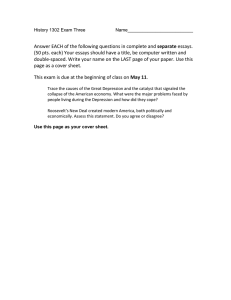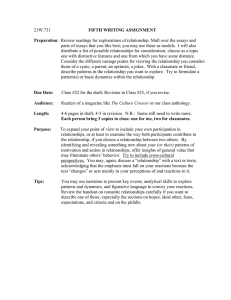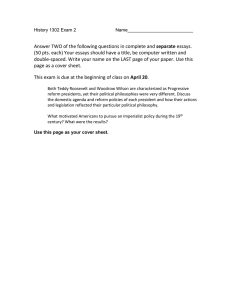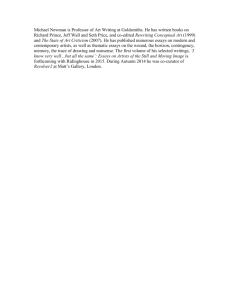ENGLISH 1301 English Composition (3-0)
advertisement
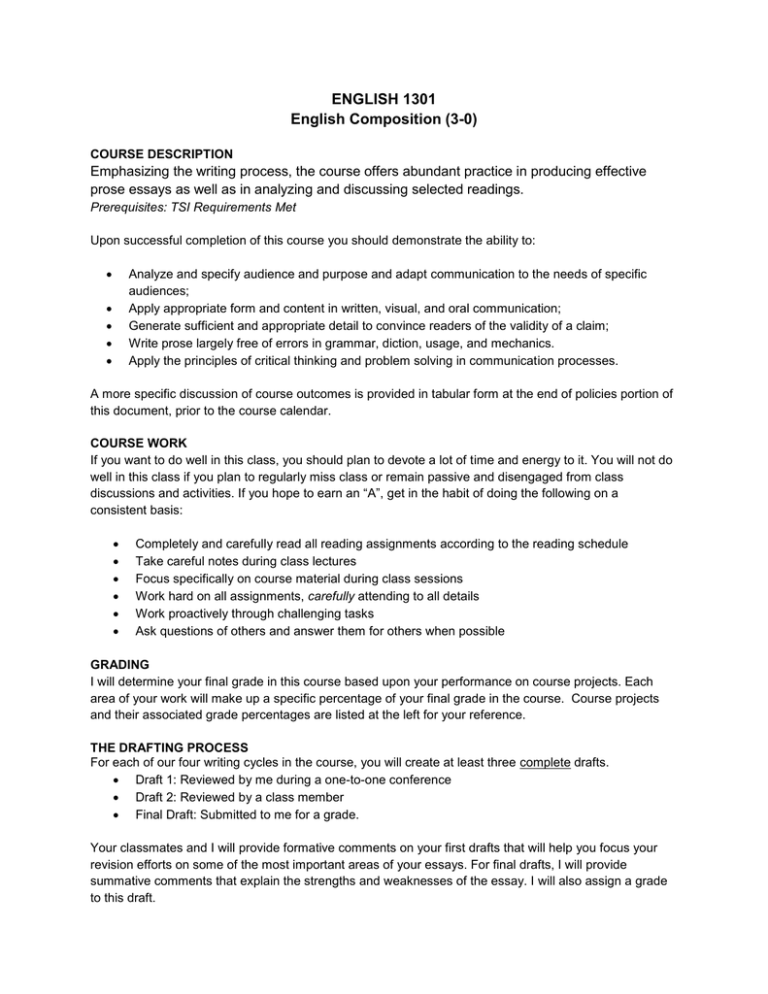
ENGLISH 1301 English Composition (3-0) COURSE DESCRIPTION Emphasizing the writing process, the course offers abundant practice in producing effective prose essays as well as in analyzing and discussing selected readings. Prerequisites: TSI Requirements Met Upon successful completion of this course you should demonstrate the ability to: Analyze and specify audience and purpose and adapt communication to the needs of specific audiences; Apply appropriate form and content in written, visual, and oral communication; Generate sufficient and appropriate detail to convince readers of the validity of a claim; Write prose largely free of errors in grammar, diction, usage, and mechanics. Apply the principles of critical thinking and problem solving in communication processes. A more specific discussion of course outcomes is provided in tabular form at the end of policies portion of this document, prior to the course calendar. COURSE WORK If you want to do well in this class, you should plan to devote a lot of time and energy to it. You will not do well in this class if you plan to regularly miss class or remain passive and disengaged from class discussions and activities. If you hope to earn an “A”, get in the habit of doing the following on a consistent basis: Completely and carefully read all reading assignments according to the reading schedule Take careful notes during class lectures Focus specifically on course material during class sessions Work hard on all assignments, carefully attending to all details Work proactively through challenging tasks Ask questions of others and answer them for others when possible GRADING I will determine your final grade in this course based upon your performance on course projects. Each area of your work will make up a specific percentage of your final grade in the course. Course projects and their associated grade percentages are listed at the left for your reference. THE DRAFTING PROCESS For each of our four writing cycles in the course, you will create at least three complete drafts. Draft 1: Reviewed by me during a one-to-one conference Draft 2: Reviewed by a class member Final Draft: Submitted to me for a grade. Your classmates and I will provide formative comments on your first drafts that will help you focus your revision efforts on some of the most important areas of your essays. For final drafts, I will provide summative comments that explain the strengths and weaknesses of the essay. I will also assign a grade to this draft. FINAL DRAFT SUBMISSION The following documents should be included in your folder when you submit a final draft to me for evaluation: Left Pocket Right Pocket Draft 1 (With My Comments Final Draft (Clean, new copy, on it) Stapled Together) Draft 2 (With Completed Revision Sheet Stapled to it) You will lose points on your assignment if you submit your folder without all of these documents included in the order and manner they are described here. Additionally, you will also need to submit a Microsoft Word version of your final draft via Blackboard by 10:00 pm on the same day you submit your folder. Your assignment will not be considered as fully submitted until I have received both your folder in class and your digital copy in Blackboard. ESSAY REVISION If you receive a grade of “D” or “F” on a final draft, you may choose to submit one more revised draft beyond the final draft for evaluation. However, the highest grade you can earn upon revision is a “C.” Keep in mind that if you decide to revise a final draft, you need to meet with me in person during my office hours or by appointment within three school-week days of receiving your final draft from me to discuss your revision strategy. You will then have just seven calendar days from our meeting to submit your revised draft. If you do not meet with me to discuss your revision, I will not accept your revised essay. You may only revise two of your four major essays. ATTENDANCE I require students to attend class, and I take attendance every day. I realize that sickness or emergencies can occur. Such absences should not occur for any student more than six times this semester. Students with absences beyond this will no longer be eligible for a passing grade in the course. Every two late arrivals to class will constitute one absence. Leaving early without a valid reason will constitute an absence. Missing a scheduled conference with me without notification will constitute an absence. For any class that you miss, please also understand that the following consequences will apply: I will not allow you to make up any assignment or exercise given and completed within the class period you missed. You will need to determine what you missed during your absence by asking your classmates or by seeing me during my office hours. I do not differentiate between “excused” absences and “non-excused absences,” so please do not bring me doctor’s notes with the expectation of having an absence excused. PARTICIPATION Attend and remain alert in every class period. Our class sessions will consist of class discussions, group activities, in-class exercises, and individual work time. I expect you to actively participate in each of these forms of learning. Missing in-class activities and exercises, arriving to class late or leaving early, falling asleep, or otherwise disengaging from course business during class will negatively impact your final course grade at my discretion. Student Learning Outcomes and Assessments THECB Core Objective Area Critical Thinking Communication University SLO Course SLO Assessment Method CT1: Gather, analyze, evaluate, and synthesize information relevant to a question or issue. Employ problem-solving strategies to generate positions and arguments and examine basic principles of information gathering to support a thesis. CT2: Develop and demonstrate a logical position (i.e. perspective, thesis, hypothesis) that acknowledges ambiguities or contradictions. CS1: Develop, interpret, and express ideas through effective written communication. Analyze and evaluate their own communication and that of others to raise questions, make assertions and generate discussion about a topic or question. Students produce five major essays; Instructors assess one of these essays using a locally produced critical thinking rubric based upon the VALUE rubrics created by the Association of American College and Universities. Students produce five major essays; Instructors assess one of these essays using a locally produced critical thinking rubric based upon the VALUE rubrics created by the Association of American College and Universities. CS2: Develop, interpret, and express ideas through effective oral communication. CS3: Develop, interpret, and express ideas through effective visual communication. Teamwork Personal Responsibility TW1: Consider different viewpoints as a member of a team. TW2: Work effectively with others to support and accomplish a shared goal. PR1: Demonstrate the ability to evaluate choices, actions and consequences as related to ethical decision-making. Take into consideration audience, purpose, and circumstances relevant to written communication; use relevant and appropriate content for the specific rhetorical situation in order to express their position(s) effectively. Take into consideration audience, purpose, and circumstances relevant to oral communication; use relevant and appropriate content for the specific rhetorical situation in order to express their position(s) effectively. Take into consideration audience, purpose, and circumstances relevant to visual communication; use relevant and appropriate content for the specific rhetorical situation in order to express their position(s) effectively. Work toward a shared purpose or goal with the members of their team, creating and evaluating their peers’ drafts, presentations and visual arguments. Devote effort to team tasks; interact with others; contribute to the team; resolve and synthesize divergent viewpoints within a group. Identify their own core beliefs and the sources of those beliefs in order to connect their choices and actions to decision-making; also recognize possible consequences of their decisions. Students produce five major essays; instructors assess one of these essays using a locally produced written communication rubric based upon the VALUE rubrics created by the Association of American College and Universities. This area is formally assessed in ENG 1302 Students produce several visual (hand-drawn) responses to course readings throughout the semester; instructors assess a selection of these responses using a locally produced visual communication rubric based upon the VALUE rubrics created by the Association of American College and Universities. This area is formally assessed in ENG 1302. This area is formally assessed in ENG 1302. Students produce two personal reflection essays; instructors assess one of these essays using a locally produced personal responsibility rubric based upon the VALUE rubrics created by the Association of American College and Universities.
